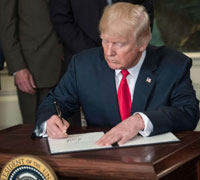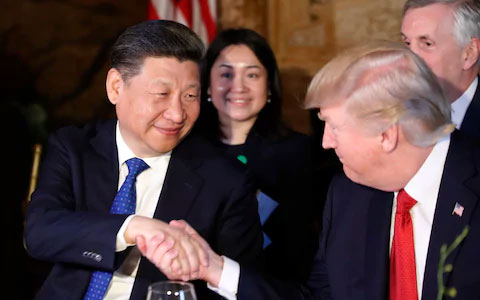"The US has been the undisputed leader in trade negotiations. Notably, so as it governs the world’s biggest share of exports of services. US exports more services than it imports from the rest of the world, a $230 billion surplus. Let’s take a look at how the entire calculation works. Apple pays its subcontractor in China, Foxconn, about $10 for product assembly, with parts shipped from multiple nations. Foxconn ships the assembled iPhone to the US at an invoice value of around $220-$210 for imported parts, $10 for assembly. This is recorded as US import from China although only $10 of the trade value was added there."
 The US has been the undisputed leader in trade negotiations. Notably, so as it governs the world’s biggest share of exports of services. US exports more services than it imports from the rest of the world, a $230 billion surplus. Let’s take a look at how the entire calculation works. Apple pays its subcontractor in China, Foxconn, about $10 for product assembly, with parts shipped from multiple nations. Foxconn ships the assembled iPhone to the US at an invoice value of around $220-$210 for imported parts, $10 for assembly. This is recorded as US import from China although only $10 of the trade value was added there. The iPhone’s $649 retail value minus $220 equaling Apple’s $429 gross margin appears nowhere in trade data. The Chinese value-added $10 component is worth $150 million – 4.5 per cent of 15 million iPhones worth $3.3 billion.
The US has been the undisputed leader in trade negotiations. Notably, so as it governs the world’s biggest share of exports of services. US exports more services than it imports from the rest of the world, a $230 billion surplus. Let’s take a look at how the entire calculation works. Apple pays its subcontractor in China, Foxconn, about $10 for product assembly, with parts shipped from multiple nations. Foxconn ships the assembled iPhone to the US at an invoice value of around $220-$210 for imported parts, $10 for assembly. This is recorded as US import from China although only $10 of the trade value was added there. The iPhone’s $649 retail value minus $220 equaling Apple’s $429 gross margin appears nowhere in trade data. The Chinese value-added $10 component is worth $150 million – 4.5 per cent of 15 million iPhones worth $3.3 billion.
Indeed, China has a principal role in the US merchandise deficit. Combining goods & services, China accounts for 59 per cent of the US trade deficit: $337 billion for China compared with $566 for the world as a whole. Tens of millions of Chinese workers slog for less than $5 per hour on behalf of the US consumers, making low-tech products, while a few million Americans in skilled jobs earn $35 or more per hour to develop aircraft and financial packages or produce soybean and pork.
Trade deficit
The US has been running deficits against the rest of the world for decades. The deficit with the world is $566 billion. In goods, that growing deficit is $796 billion, although in services the US posts a surplus, also growing, of $230 billion. Imports from China amount to $524 billion, or 18 per cent of the US’ total imports of $2,895 billion. The US runs a surplus with few countries. Most are small. The combined surplus with the top 15 of such nations, including the Netherlands, the United Kingdom and Guatemala, is just over $148 billion. The rest of the world, including China, partially finances the US trade deficit. The Chinese do not need or use dollars in their country. Chinese firms turn them over to local banks in exchange for their own currency, and banks turn them over to their central bank. The central bank reinvests that surplus in US assets, mainly Treasury securities. This helps prop up the US Government budget, keeping the US dollar strong and aiding US consumers with affordable goods and low interest rates for mortgages and credit cards while maintaining Chinese jobs. The US Government, spending more than it takes in from domestic tax revenue, has run a deficit for most of the last 35 years. But it still funds expenditures like defense and, has accumulated $19 trillion in debt.
billion. In goods, that growing deficit is $796 billion, although in services the US posts a surplus, also growing, of $230 billion. Imports from China amount to $524 billion, or 18 per cent of the US’ total imports of $2,895 billion. The US runs a surplus with few countries. Most are small. The combined surplus with the top 15 of such nations, including the Netherlands, the United Kingdom and Guatemala, is just over $148 billion. The rest of the world, including China, partially finances the US trade deficit. The Chinese do not need or use dollars in their country. Chinese firms turn them over to local banks in exchange for their own currency, and banks turn them over to their central bank. The central bank reinvests that surplus in US assets, mainly Treasury securities. This helps prop up the US Government budget, keeping the US dollar strong and aiding US consumers with affordable goods and low interest rates for mortgages and credit cards while maintaining Chinese jobs. The US Government, spending more than it takes in from domestic tax revenue, has run a deficit for most of the last 35 years. But it still funds expenditures like defense and, has accumulated $19 trillion in debt.
Dumping occurs when unprincipled importers sell products below cost and hurt competing local producers. Most international marketers practice global price discrimination, pricing products at what each country’s market can bear, thus maximizing overall global revenue and profits. Such dumping forces local producers to reduce prices, occasionally driving them to reduce workforce or even shut shops. In light to this, the Trump administration has accused Chinese steel and aluminum firms of dumping. China has excess capacity, more than its domestic market demands, aided by cheap loans and land from the Chinese Government. The Chinese companies are probably not losing money. But so-called dumping also results in multibillion-dollar benefits to the US and other countries with low-cost steel and aluminum for cars, machinery and other products.
Learning the trade secrets
Chinese regulations don’t allow foreign firms to invest and do business in China without taking on a local company as a partner, though the norms have been relaxed recently. While the US may have superior capabilities but the US laws generally frown upon government covertly helping US firms. In a nutshell, these three factors would still hold the supremacy for the US industries: Foreign and domestic investors continue to have faith in the dollar as safe haven, investing in US Treasury bills and bonds; Foreign workers continue to toil for wages at less than $5 per hour; and US employment remains at tolerable levels.












